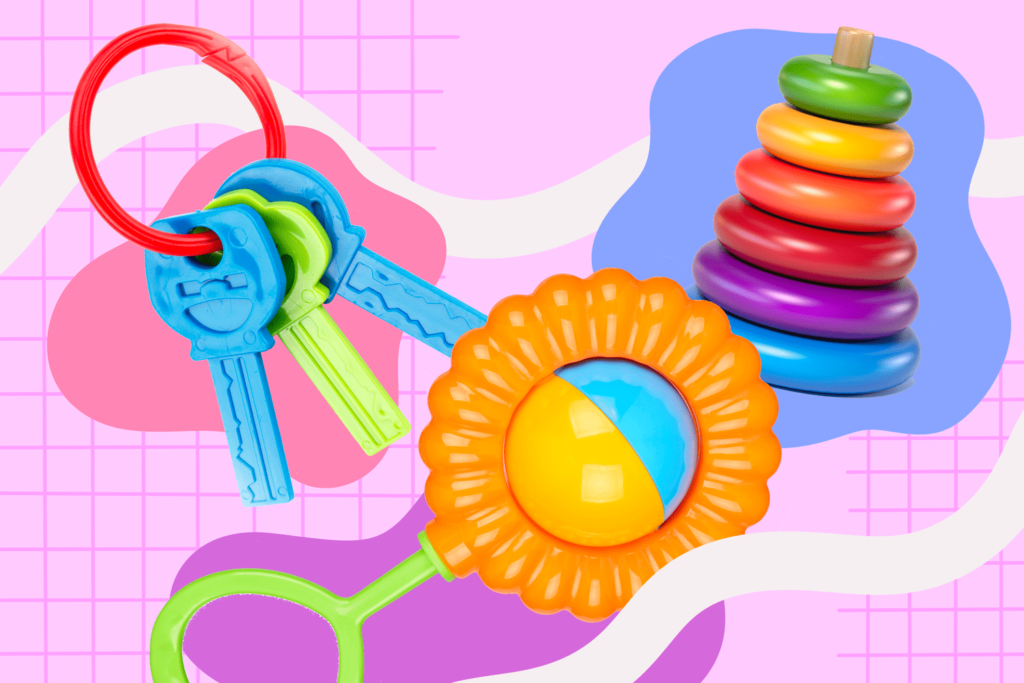If you currently find yourself surrounded by an array of colorful objects, none of which are breakable and all of which are safe for babies, you just might be a new parent. Filling your young child’s life with baby toys and playthings is arguably one of the most fun aspects of the job.
But as you lovingly watch, you’ll likely notice your baby drooling all over those once shiny toys, dropping them to the floor, and then putting them right back in their mouth. Because of this, it’s common to wonder how to clean baby toys safely and effectively. Here’s what to know.
Parents / Madelyn Goodnight / Getty Images
What You Need to Clean Baby Toys
You likely own a number of cleaning products that are safe to use on plastic baby toys, such as Clorox or Lysol wipes, 3% hydrogen peroxide solution, and chlorine bleach. You can also check the baby care aisle of any grocery or drugstore, as you’re bound to spot some bottled cleaners specifically geared toward sanitizing toys.
“Toys are likely going into your babe’s mouth, so you’ll want to be sure to consider using a safe chemical for sanitation, such as vinegar, alcohol, or peroxide,” says Brandi Winch, owner of Homemaid Cleaning Service.
Step-by-Step Guide to Cleaning Plush Toys
When cleaning your baby’s plush toys, it’s most efficient to run them through the washer and dryer. Here’s how.
- Place the stuffed animals in a linen or mesh bag, particularly if they’re small or have clothing that might get lost or damaged in the wash.
- Run the washer on the delicate cycle. “You can add vinegar to the wash cycle for sanitation purposes instead of bleach. Bleach is likely to discolor those beloved stuffies, and no one wants that,” says Winch.
- Follow up with a nice fluffing in the dryer—also set to delicate.
“Plush toys can get pretty gross pretty fast,” says Winch. “Most people underestimate the simple power of just running those bad boys through the washer and dryer! It’s so nice to have a freshly washed stuffy every now and again.”
Step-by-Step Guide to Cleaning Plastic Toys
Winch recommends two ways of cleaning plastic toys.
Soaking: Submerge the toys in a bath of water, along with the cleaning product, so they can soak. “Make sure the surface of the toy is soaked for the duration of the kill time needed for sanitizing, typically a couple of minutes,” Winch says. She also advises that you refrain from using a disinfecting wipe, which likely won’t keep the surface wet enough to properly kill those pesky germs.
Spraying: Another option is spraying toys down and placing them on a clean surface to marinate for two to three minutes. Allow the toys to air dry with the cleaning product still on them. Then, rinse the toys in warm water to rid them of any chemicals. Finally, allow the toys to air dry once more rather than wipe them down with a towel.
Step-by-Step Guide to Cleaning Bath Toys
Bath toys are often plastic, so you can use similar methods as with other plastic toys:
- Soak them in a tub of water with a cleaning product.
- Spray them down with a cleaning product and let them marinate for two to three minutes.
- Disinfecting wipes may seem like an easy solution, but they often have a hard time getting in all the nooks and crannies toys have.
Bath toys are notorious for getting gross quickly, as they’re constantly exposed to water. This can quickly lead to mold, especially in areas that may fill with water (like those pesky holes on the bottom of hollow toys). To combat this, fill those areas with your cleaning solution and allow it to soak. Once the soak is done, squeeze out all the product before rinsing.
As Wise suggests, after your bath toys are good and soaked, you should allow them to dry with the cleaning product still on them. Then, rinse in warm water (including rinsing inside any hollow areas) and allow to air dry once more.
Important Considerations for Cleaning Baby Toys
For starters, do not place anything in the washing machine that includes a battery pack. The beloved dancing Elmo that once uttered adorable phrases will no longer have that talent if it goes through the wash.
Pay special attention to bath toys, which often have holes in the bottom. It’s important to squeeze all water out after each use so they have time to dry completely before taking another dunk in the tub. Otherwise, these toys can become a hotbed for bacteria.
“Prevention is going to be a key factor in bath toy maintenance,” says Winch. “First, make sure your bath toys are all or primarily impermeable. Cloth bath toys or bath toys with holes in them require a lot more care. Second, invest in a mesh bag that hangs and will allow the toys to drain and be exposed to air between uses. Third, make sure to give the toys a quick rinse after use before placing them in their mesh bag.”
Baby Toy Cleaning Frequency
Winch recommends washing plush toys as needed or every few months, plastic toys every other month, and wood toys two to three times a year.
Keeping your baby happy and healthy is of utmost importance to parents and caregivers. This often involves a lot of washing and cleaning to keep germs at bay. Use this advice when you’re tackling your child’s toy box, but give yourself grace if those items don’t get a full scrub down this month or next. You and your baby are doing great.
